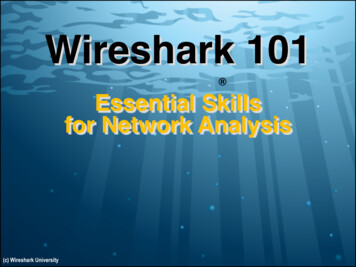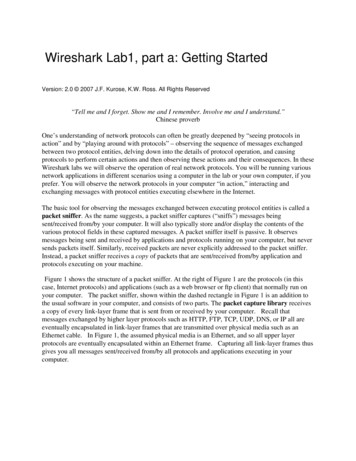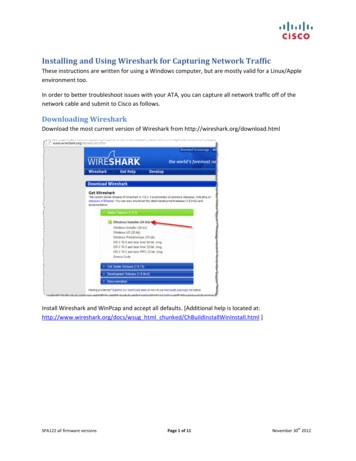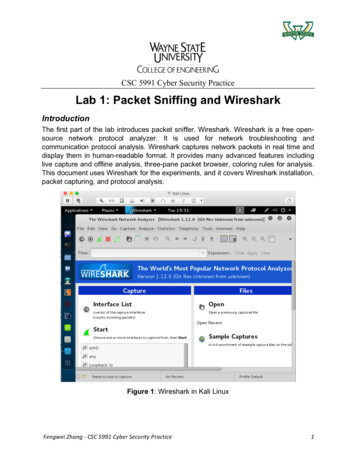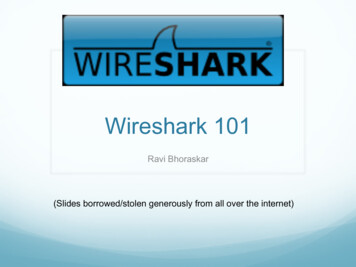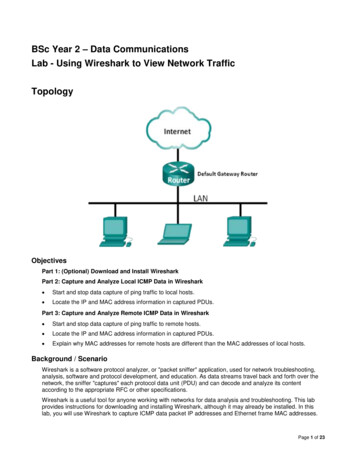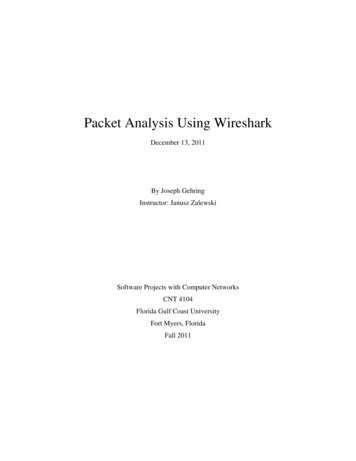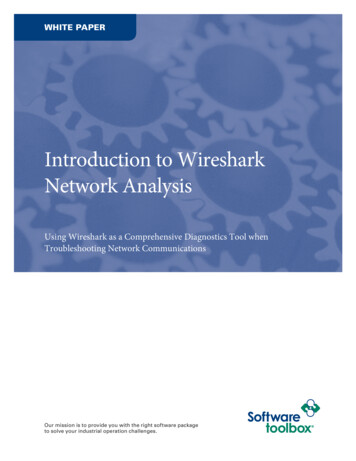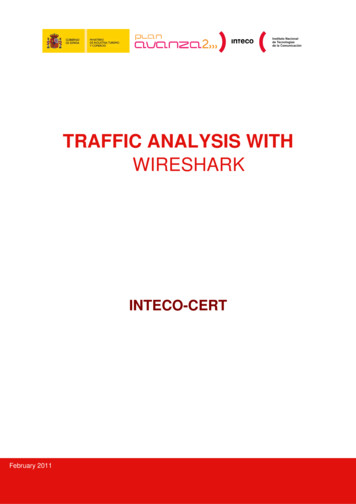
Transcription
SharkFest ’18 ASIASSL/TLS Decryptionuncovering secretsWednesday April 11th, 2018Peter WuWireshark Core Developerpeter@lekensteyn.nl1#sf18asia NEC, Nanyang Technological University, Singapore April 9-11
About meI Wireshark contributor since 2013, core developer since 2015.I Areas of interest: TLS, Lua, security, . . .I Developed a VoIP product based on WebRTC.I InfoSec Master’s student @ TU/e (NL).I Cloudflare crypto intern in 2017.2#sf18asia NEC, Nanyang Technological University, Singapore April 9-11
SecretsI Things that people care about: pictures,videos, documents, email conversations,passwords, . . .I Application Data: cookies, API keys, RequestURI, User Agent, form data, response body, . . .I How to keep these safe when sending it overthe internet or over your local Wi-Fi network?3#sf18asia NEC, Nanyang Technological University, Singapore April 9-11
Transport Layer Security (TLS)I Provides secure communication channel between two endpoints (client and server).I Network protocol with two components:I Handshake Protocol: exchange capabilities, establish trust and establish keys.I Record Protocol: carries messages and protects application data TCP TCPIPIP.TLSTCPIP.Server4#sf18asia NEC, Nanyang Technological University, Singapore April 9-11
Secure Sockets Layer (SSL) versus Transport Layer Security (TLS)I SSLv3: old (RFC 6101, 1996) and deprecated (RFC 7568, 2015). Do not use it!I TLS 1.0 (RFC 2246, 1999), 1.1 (RFC 4346, 2006), 1.2 (RFC 5246, 2008).I Changes:I New versions are generally fixing weaknesses due to new attacks.I TLS 1.0 (RFC 3546, 2003) and up allow for extensions, like Server Name Indication(SNI) to support virtual hosts.I TLS 1.2: new authenticated encryption with additional data (AEAD) mode.I “SSL” term still stuck, e.g. “SSL certificate”, “SSL library” and field names inWireshark (e.g. ssl.record.content type).I Mail protocols: TLS often refers to STARTTLS while SSL directly starts with thehandshake.5#sf18asia NEC, Nanyang Technological University, Singapore April 9-11
“Secure” communication channelI Symmetric-key algorithms: encrypt/decrypt bulk (application) data using a single(secret) symmetric key. Examples: AES, 3DES, RC4.I How to create such a secret? For example, AES-256 needs a 256-bit key.I Public-key cryptography: a (secret) private key and a related public key.IIIIMathematically hard to compute private key from public key.Encrypt data with public key, decrypt with private key.Limitation: maximum data size for RSA is equal to modulus size, 2048-4096 bits.Idea: generate a random premaster secret and encrypt it with the RSA public key.I Where to retrieve this RSA public key from?6#sf18asia NEC, Nanyang Technological University, Singapore April 9-11
Certificates and trustI Public key is embedded in an X.509 certificate.I How can this certificate be trusted?I A Certificate Authority (issuer) signs thecertificate with its private key.I Public-key cryptography: use a private (secret)key and a public key with small data.I Compress data using a hash function.Examples: SHA256, SHA1, MD5.I Sign hash with private key, verify with publickey. Examples: RSA, ECDSA.I Root CAs are self-signed and installed by theOS vendor or local admin (Group Policy, etc.).7#sf18asia NEC, Nanyang Technological University, Singapore April 9-11
TLS handshake with RSA key exchange methodI Client Hello advertises supported parameters, Server Hello decides.I Server picks RSA key exchange: TLS RSA WITH AES 128 CBC SHA. Certificate (with RSA public key) ServerHelloDone8#sf18asia NEC, Nanyang Technological University, Singapore April 9-11
TLS handshake with RSA key exchange method - ClientKeyExchangeI Client received Server Hello and now knows protocol version and cipher suite.I Client generates a new random 48-byte premaster secret, encrypts it using thepublic key from the Certificate and sends the encrypted result to the server in aClientKeyExchange message.I Using the private RSA key, server (or anyone else!) decrypts the premaster secret.9#sf18asia NEC, Nanyang Technological University, Singapore April 9-11
TLS handshake with RSA key exchange method - Finishing upI Both sides calculate the 48-byte mastersecret based on the Client Random,Server Random and the premaster secret.I Both sides derive symmetric keys from thismaster secret, send the ChangeCipherSpecmessage to start record protection.I Finally they both finish the Handshakeprotocol by sending a Finished Handshakemessage over the encrypted record layer.I Now the actual encrypted ApplicationData can be sent and received.10#sf18asia NEC, Nanyang Technological University, Singapore April 9-11
Handshake overviewClientServerClientHello-------- loDone-------- [ChangeCipherSpec] -------FinishedApplication Data ------- Application DataSimplified TLS handshake (adapted from RFC 5246 (TLS 1.2))#sf18asia NEC, Nanyang Technological University, Singapore April 9-1111
Plaintext pleaseI Server administrators can check application logs.I Web browsers provide developer tools.I What if the information is not logged?I What if you want to know what this third-party Android app is doing?I What if the application under investigation is poorly documented?I What if you want to debug your new HTTP/2 feature?I Solution: packet capture plus SSL/TLS secrets!12#sf18asia NEC, Nanyang Technological University, Singapore April 9-11
Decryption using private RSA server keyConfigure Wireshark with a RSA private key file1 :I IP address is unused and ignored. Port -----BEGIN PRIVATE KEY---- Protocol can be empty. These three JLf5wAm6T6BHUpjUsfZvMfGorx8fVBtd8WbCXL7PFKfields will be removed in future.I Specify (passwordless) PEM-encoded key PrTBLm7FuKMew0bWgn4GfGdwuvP9C FoaG8 s file or PKCS#12 key file password. -----END PRIVATE KEY----1See https://wiki.wireshark.org/SSL#Preference Settings#sf18asia NEC, Nanyang Technological University, Singapore13 April 9-11
Limitations of RSA private keyI Clients usually do not have access to the RSA key, only server operators can use it.I In case of mutual authentication (client certificates), the private key is only usedfor signing. The client private RSA key cannot decrypt.I Encrypted premaster secret is not sent with resumed sessions.ClientServerClientHello-------- [ChangeCipherSpec]FinishedApplication Data --- ------- Application DataMessage flow for an abbreviated handshake (RFC 5246, Figure 2)#sf18asia NEC, Nanyang Technological University, Singapore April 9-1114
Ephemeral (Elliptic Curve) Diffie-Hellman (ECDHE)I Decryption using RSA private key not possible with cipher suites likeTLS ECDHE ECDSA WITH AES 128 GCM SHA256 andTLS ECDHE RSA WITH AES 128 GCM SHA256.I Although it has RSA in its name, it is not used for encryption, but signing.I Instead it uses Diffie-Hellman to establish a shared secret (the premaster secret)based on ephemeral secrets (different secrets for every session).I Server chooses a group/curve, generates private value and its related public valueand sends it to the client. Client uses same group/curve and also generates a pair.I Computationally hard to find the private value given the public one.15#sf18asia NEC, Nanyang Technological University, Singapore April 9-11
TLS secrets summaryI Any of these can be used for decryption with passive captures:I premaster secret: RSA-encrypted or output from DH key exchange.I Master secret: derived from premaster secret and handshake messages. Also used forsession resumption.I Symmetric encryption key for record encryption.I RSA private key file (for RSA key exchange, covered before).I So how to use master secrets?16#sf18asia NEC, Nanyang Technological University, Singapore April 9-11
SSL key log fileI Text file with master secrets2 .I Works for any cipher, including RSA and DHE.I Clients can use this too!I Set environment variable SSLKEYLOGFILE before starting Firefox or Chrome. Thevariable is only read during startup, so restart if necessary.I Format: CLIENT RANDOM Client Hello Random master secret .# SSL/TLS secrets log file, generated by NSSCLIENT RANDOM ce4d0d1df63ad8CLIENT RANDOM 3bd5fb19c90061CLIENT RANDOM 989d05c51cc3abCLIENT RANDOM 983ea74f07900eCLIENT RANDOM e417d3d12b3755CLIENT RANDOM d7dc78b711638bCLIENT RANDOM File format at https://developer.mozilla.org/NSS Key Log Format#sf18asia NEC, Nanyang Technological University, Singapore April 9-1117
Using SSL key log file in WiresharkI Configure file in Wireshark preferences: Edit Preferences; Protocols SSL;(Pre-)Master Secret log filename.I Key log file is also read during a live capture. And if the file is removed and a newfile is written, the new key log file is automatically read.I Caveat: key log is read while processing ChangeCipherSpec. If key is written toolate, trigger a redissection (e.g. change a preference or (Un)ignore a packet).18#sf18asia NEC, Nanyang Technological University, Singapore April 9-11
Application and library supportI Any application built using NSS and GnuTLS enable key logging via theSSLKEYLOGFILE environment variable.I Applications using OpenSSL 1.1.1 or BoringSSL d28f59c27bac (2015-11-19) canbe configured to dump keys:v o i d S S L C T X s e t k e y l o g c a l l b a c k ( SSL CTX c t x ,v o i d ( cb ) ( c o n s t SSL s s l , c o n s t c h a r l i n e ) ) ;I ARM Mbed TLS using a debug callback3 .I cURL supports many TLS backends, including NSS, GnuTLS and OpenSSL. Keylogging with OpenSSL/BoringSSL is possible since curl 7.56.04 .I Java applications can use jSSLKeyLog5 ea15Requires a build time option, see https://curl.haxx.se/bug/?i 18665http://jsslkeylog.sourceforge.net#sf18asia NEC, Nanyang Technological University, Singapore April 9-11419
Key log with OpenSSL 1.1.0 and beforeI Why: many applications (including Python) use OpenSSL.I Problem: older OpenSSL versions have no key log callback.I Solution: intercept library calls using a debugger or an interposing library(LD PRELOAD) and dump keys6 .I Example with OpenSSL 1.1.0f using an intercepting library7 : export SSLKEYLOGFILE some.keys LD PRELOAD ./libsslkeylog.so curl https://example.com. cat some.keysCLIENT RANDOM 032212FCA24B89 rk-notes/tree/src#sf18asia NEC, Nanyang Technological University, Singapore20 April 9-11
Unsupported applications for SSLKEYLOGFILEI Windows native TLS library is Secure Channel (SChannel). Feature request forMicrosoft Edge browser is pending8 .I Extracting secrets from SChannel is not impossible (but neither easy) though9 .I Apple macOS applications use SecureTransport, also not asia NEC, Nanyang Technological University, Singapore April 9-1121
Alternative ways to get the secretI Force RSA key exchange (disable forward-secret cipher suites).I Setup a fake CA and force traffic through a proxy like mitmproxy10 , OWASP Zap,Fiddler or Burp Suite.I All of these methods can be detected by the client. Certificate pinning can alsodefeat the custom CA method.I The proxy interception method may also weaken security11 .I If you are really serious about a passive, nearly undetectable attack from ahypervisor, see the TeLeScope experiment12 ogfile.htmlDurumeric et. al., The Security Impact of HTTPS he-depths-of-tls-traffic-in-real-time/#sf18asia NEC, Nanyang Technological University, Singapore April 9-111122
Feature: Follow SSL StreamI Display the contents of thedecrypted application data.I Right-click in the packet list ordetails view, Follow SSL Stream.I Great for text-based protocols likeSMTP. For binary data, try the HexDump option.I Click on data to jump to relatedpacket (in packet list). Note that adisplay filter can hide packets, clearthe filter to avoid that.23#sf18asia NEC, Nanyang Technological University, Singapore April 9-11
Feature: Export HTTP ObjectsI After decryption is enabled, HTTPpayloads within TLS (HTTPS) canbe exported.I File Export Objects HTTP. . .I Click on an item to select it in thepacket list.I Note: does not cover HTTP/2 norQUIC (yet?) as of Wireshark 2.6.24#sf18asia NEC, Nanyang Technological University, Singapore April 9-11
Feature: Export SSL Session KeysI Suppose you have a capture which is decrypted using a RSA private key file. Howto allow others to decrypt data without handing over your RSA private key file?I File Export SSL Session Keys. . .I Generates a key log file which can be used instead of the private RSA key file.I Note: currently contains all keys. Remove lines which are not needed (match bythe second field, the Random field from Client Hello).25#sf18asia NEC, Nanyang Technological University, Singapore April 9-11
Feature: Display FiltersI Display filters can be used for filtering, columns and coloring rules.I Discover by selecting a field in packet list, look in status bar.I Recognize TCP/TLS stream in packet list: Right-click TCP Stream Index(tcp.stream) field in packet details, Apply as Column.I Right-click field in packet details, Apply/Prepare as Filter.I SNI in Client Hello: ssl.handshake.extensions server nameI Change in Wireshark 2.4: ssl.handshake.random selects full Client or ServerRandom instead of the just the Random Bytes field. Reason: real time is often nolonger included, full bytes field is useful for matching with key log file.26#sf18asia NEC, Nanyang Technological University, Singapore April 9-11
Feature: Decode AsI Force dissector for custom ports. Decode as SSL (TCP) or DTLS (UDP).I Select application data protocol within SSL/TLS layer (since Wireshark 2.4).I Example: HTTPS on non-standard TCP server port 4433.I Right-click TCP layer, Decode As. Change current protocol for TCP Port to SSL.I Press OK to apply just for now or Save to persist this port-to-protocol mapping.I Right-click SSL layer, Decode As. Change current protocol for SSL Port to HTTP.I For STARTTLS protocols, select SMTP/IMAP/. . . instead of SSL for TCP Port.I Tip: there are many protocols, just select the field, then use arrow keys or typethe protocol name (typing H gives HTTP).27#sf18asia NEC, Nanyang Technological University, Singapore April 9-11
Feature: TsharkI Tshark: command-line tool, useful to extract information as text, especially whenthe query is repeated multiple times.I Find all cipher suites as selected by the server: tshark -r some.pcap-Tfields -e ssl.handshake.ciphersuite -Y ssl.handshake.type 2I List all protocol fields: tshark -G fieldsI Configure keylogfile:tshark -ossl.keylog file:firefox.keys -r firefox.pcapng.gzI Configure RSA keyfile (fields correspond to the RSA keys dialog):tshark -ouat:ssl keys:’"","","","keys/rsasnakeoil2.key",""’I Decode DNS-over-TLS13 on non-standard port:tshark -d tcp.port 53053,ssl -d ssl.port 53053,dnsI Tshark manual: ml13Sample: andard-port.pcapng#sf18asia NEC, Nanyang Technological University, Singapore April 9-1128
Future: TLS 1.3I Replaces all previous cipher suites with new one. Dropped all old cipher suites (nomore CBC, RC4, NULL, export ciphers).I RSA key exchange is gone, all ciphers are forward secret.I Encrypted early (0-RTT) data.I Encrypted server extensions (like ALPN).I Encrypted server certificate.I Multiple derived secrets for resumption, handshake encryption, application dataencryption. (Safer resumption!)I Decryption and dissection is supported by Wireshark (drafts 18-23 as of Wireshark2.4.5, drafts 18-26 as of Wireshark 2.6).29#sf18asia NEC, Nanyang Technological University, Singapore April 9-11
Known issuesI Out-of-Order TCP segments break dissection and decryption (Ignored UnknownRecord). https://bugs.wireshark.org/bugzilla/show bug.cgi?id 9461I Large certificates result in handshake fragmentation. Not displayed becausereassembly for handshake messages is not implemented yet.https://bugs.wireshark.org/bugzilla/show bug.cgi?id 330330#sf18asia NEC, Nanyang Technological University, Singapore April 9-11
ConclusionsI RSA private keys cannot be used for decryption in all cases.I The key log method (SSLKEYLOGFILE) can also be used by clients and works withall cipher suites.I TLS 1.3 debugging is even more difficult without decryption.I Use latest Wireshark version, especially if you are doing any TLS 1.3 work.31#sf18asia NEC, Nanyang Technological University, Singapore April 9-11
Using SSL key log le in Wireshark I Con gure le in Wireshark preferences: Edit ! Preferences; Protocols ! SSL; (Pre-)Master Secret log lename. I Key log le is also read during a live capture. And if the le is removed and a new le is written, the new key log le is automatically read. I C
